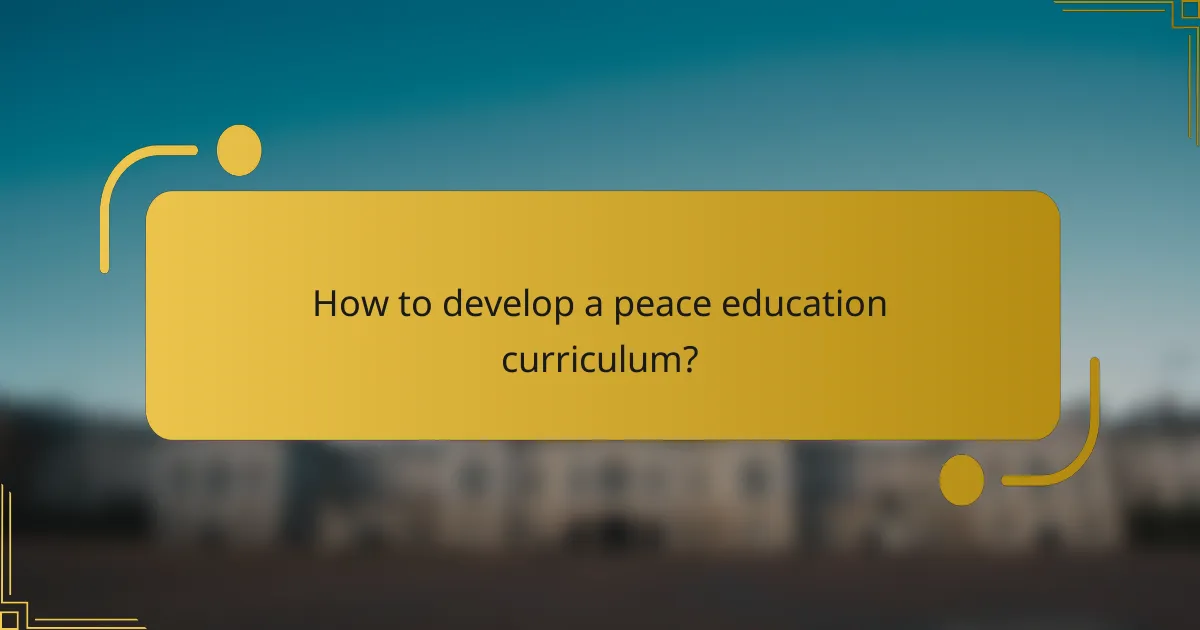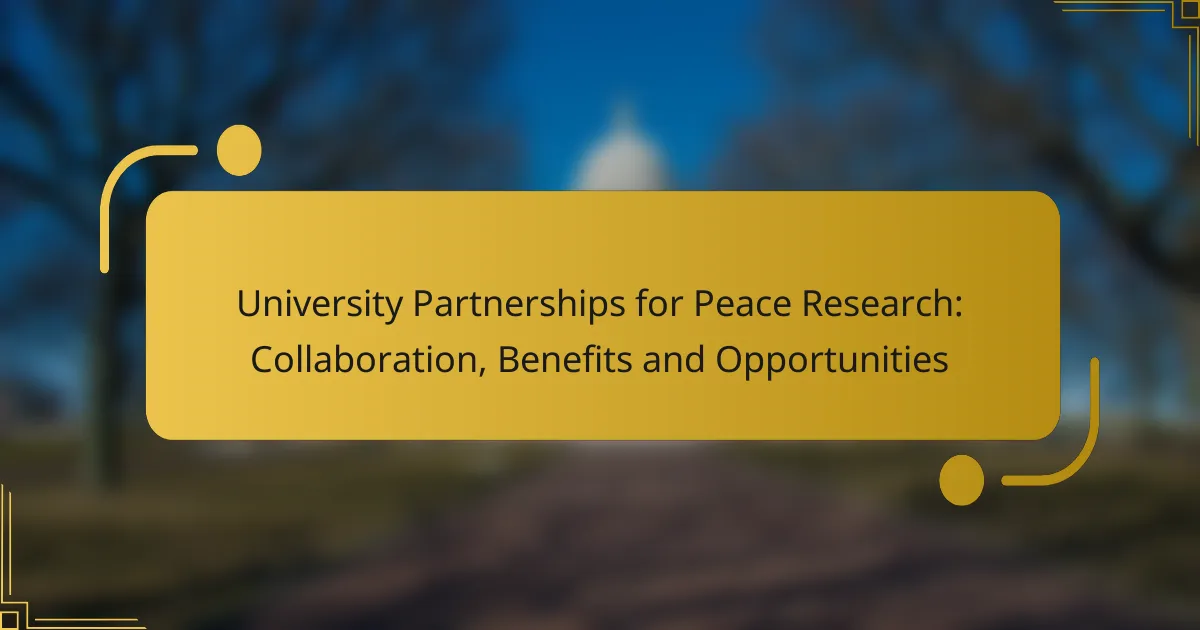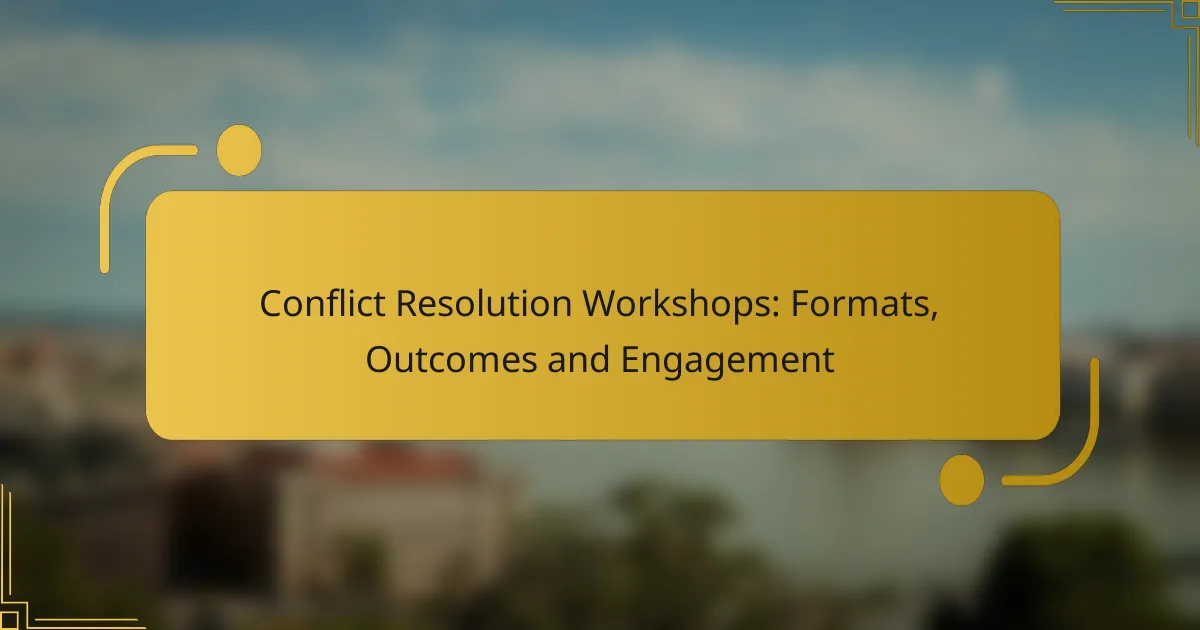The peace education curriculum aims to cultivate essential social-emotional skills, conflict resolution abilities, and community engagement among students. By systematically developing and implementing programs tailored to community needs, educators can promote values of empathy and active citizenship. Best practices emphasize comprehensive frameworks, teacher training, and collaborative learning environments to ensure meaningful integration of peace education into the overall curriculum.

What are effective peace education curriculum solutions in the United States?
Effective peace education curriculum solutions in the United States focus on fostering social-emotional skills, conflict resolution, and community involvement. These programs are designed to promote understanding, empathy, and active citizenship among students, preparing them to navigate and resolve conflicts peacefully.
Social-Emotional Learning Integration
Integrating social-emotional learning (SEL) into peace education helps students develop essential skills such as self-awareness, self-regulation, and interpersonal skills. Programs often include activities that encourage reflection on personal feelings and relationships, which can enhance empathy and cooperation.
For instance, schools can implement SEL frameworks like the Collaborative for Academic, Social, and Emotional Learning (CASEL) model, which emphasizes competencies such as responsible decision-making and relationship skills. This integration can lead to improved classroom behavior and academic performance.
Conflict Resolution Strategies
Conflict resolution strategies are crucial components of peace education, teaching students how to address disagreements constructively. Techniques such as active listening, negotiation, and mediation empower students to resolve conflicts without resorting to violence.
Schools can adopt programs like Peer Mediation, where trained student mediators facilitate discussions between peers in conflict. This not only helps resolve issues but also builds leadership skills and a sense of responsibility among students.
Community Engagement Projects
Community engagement projects connect students with their local environments, fostering a sense of belonging and responsibility. These projects can range from service-learning initiatives to partnerships with local organizations focused on social justice and peacebuilding.
For example, students might participate in neighborhood clean-up days or collaborate with local nonprofits to address community issues. Such involvement helps students understand the impact of their actions and promotes civic responsibility.
Restorative Justice Practices
Restorative justice practices focus on repairing harm and restoring relationships rather than punishing offenders. This approach encourages accountability and empathy, allowing students to understand the consequences of their actions and the importance of making amends.
Schools can implement restorative circles, where affected parties come together to discuss the impact of a conflict and collaboratively determine how to repair the harm. This practice can lead to a more supportive school climate and reduce recidivism among students.
Global Citizenship Education
Global citizenship education prepares students to engage with global issues and understand their roles as active participants in a diverse world. This aspect of peace education emphasizes awareness of global interconnections and the importance of cultural understanding.
Curricula may include discussions on human rights, environmental sustainability, and social justice, encouraging students to think critically about their responsibilities to others. Schools can enhance this education through international partnerships or exchange programs that expose students to different cultures and perspectives.

How to develop a peace education curriculum?
Developing a peace education curriculum involves a systematic approach that addresses the specific needs of the community while promoting values of peace and conflict resolution. Key steps include assessing community needs, involving stakeholders, designing a robust framework, and allocating resources effectively.
Needs Assessment Process
The needs assessment process is crucial for identifying the specific peace education requirements of a community. This can involve surveys, interviews, and focus groups to gather insights from students, teachers, and community members.
Consider using a combination of qualitative and quantitative methods to ensure a comprehensive understanding of the local context. Aim to identify existing conflicts, cultural dynamics, and educational gaps that the curriculum should address.
Stakeholder Involvement
Engaging stakeholders is essential for the successful development of a peace education curriculum. Key stakeholders typically include educators, parents, community leaders, and local organizations.
Facilitate regular meetings and workshops to gather input and foster collaboration. This involvement not only enhances the curriculum’s relevance but also builds community ownership and support for peace initiatives.
Curriculum Framework Design
The curriculum framework should outline the core objectives, content areas, and teaching methodologies. Focus on integrating themes of conflict resolution, empathy, and social justice into various subjects.
Utilize existing educational standards as a guide, but ensure that the framework is adaptable to local cultural contexts. Incorporate diverse teaching methods, such as experiential learning and collaborative projects, to engage students effectively.
Resource Allocation Strategies
Effective resource allocation is vital for implementing a peace education curriculum. Identify necessary materials, such as textbooks, training programs, and community resources, and prioritize their acquisition based on budget constraints.
Consider leveraging partnerships with local NGOs or government programs to enhance resource availability. Regularly evaluate resource use to ensure alignment with curriculum goals and make adjustments as needed.

What are best practices for implementing peace education?
Best practices for implementing peace education focus on creating a comprehensive framework that fosters understanding, respect, and collaboration among students. Effective implementation involves teacher training, collaborative learning environments, and robust assessment techniques to ensure that peace education is integrated meaningfully into the curriculum.
Teacher Training Programs
Teacher training programs are essential for equipping educators with the skills and knowledge necessary to deliver peace education effectively. These programs should cover conflict resolution, emotional intelligence, and cultural sensitivity, enabling teachers to create a supportive classroom atmosphere.
Workshops and ongoing professional development can enhance teachers’ abilities to facilitate discussions around sensitive topics. Programs should also encourage peer learning and mentorship to strengthen the community of educators committed to peace education.
Collaborative Learning Environments
Creating collaborative learning environments is crucial for peace education, as they promote teamwork and mutual respect among students. Group projects, discussions, and role-playing exercises can help students practice conflict resolution and empathy in real-world scenarios.
Incorporating diverse perspectives through group activities allows students to appreciate different viewpoints and fosters a culture of inclusivity. Schools should encourage partnerships with local organizations to provide students with opportunities for community engagement and service learning.
Assessment and Evaluation Techniques
Assessment and evaluation techniques for peace education should focus on both qualitative and quantitative measures. Traditional tests may not fully capture students’ understanding of peace concepts; therefore, alternative assessments like portfolios, self-reflections, and peer evaluations can provide deeper insights.
Regular feedback from students about their learning experiences can help educators adjust their approaches and improve the curriculum. Schools may also consider using rubrics that emphasize skills such as collaboration, critical thinking, and communication to evaluate student progress effectively.

What are the challenges in peace education curriculum implementation?
Implementing a peace education curriculum faces several significant challenges that can hinder its effectiveness. Key obstacles include insufficient funding, resistance from educational institutions, and cultural sensitivity issues that must be navigated carefully.
Lack of Funding
Insufficient funding is a primary barrier to implementing peace education programs. Many schools and educational institutions struggle to allocate resources for new curricula, particularly in regions where budgets are tight. This can lead to a lack of training for educators and inadequate materials for students.
To address funding issues, schools can seek partnerships with non-profit organizations, government grants, or community sponsorships. Engaging local businesses and stakeholders can also provide necessary financial support and resources.
Resistance from Educational Institutions
Resistance from educational institutions often stems from a lack of understanding or support for peace education initiatives. Some educators may view these programs as non-essential or outside the traditional curriculum, leading to reluctance in adopting them.
Building a strong case for the benefits of peace education, such as improved student well-being and conflict resolution skills, can help overcome this resistance. Providing professional development opportunities for educators can also foster a more supportive environment for these programs.
Cultural Sensitivity Issues
Cultural sensitivity is crucial in peace education, as curricula must respect and reflect the diverse backgrounds of students. Misalignment with local values or beliefs can lead to pushback from parents and communities.
To ensure cultural relevance, educators should involve community leaders and parents in the curriculum development process. This collaboration can help tailor the content to reflect local customs and values, making peace education more acceptable and effective.

How to measure the effectiveness of peace education?
Measuring the effectiveness of peace education involves assessing both immediate outcomes and long-term impacts on students’ attitudes and behaviors. Effective measurement can include various methods such as surveys, observational studies, and academic performance evaluations.
Student Feedback Mechanisms
Gathering student feedback is crucial for evaluating peace education programs. Surveys and focus groups can provide insights into students’ perceptions of the curriculum and its relevance to their lives. Consider using anonymous feedback tools to encourage honest responses.
Incorporating regular feedback sessions allows educators to adjust teaching methods and content based on student input. This iterative process helps ensure that peace education remains engaging and effective.
Longitudinal Impact Studies
Longitudinal impact studies track students over time to assess the lasting effects of peace education. These studies can reveal changes in behavior, conflict resolution skills, and community involvement, providing a comprehensive view of the program’s success.
Implementing such studies requires careful planning, including defining measurable outcomes and selecting appropriate control groups. Collaborating with educational researchers can enhance the study’s credibility and help in analyzing data effectively.



